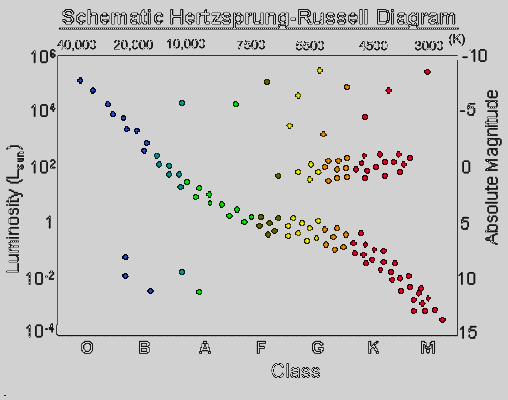
Due October 30th, 2012
Name:___________________________________
1) The HR diagram is plotted below. On this diagram (just write in labels at the correct spots), identify the locations of the following objects: a) the Sun, b) white dwarfs, c) main sequence M-type stars, d) red giants, e) blue supergiants, f) main sequence B-type stars. (12pts)

(For Question 2:)
The formula for the luminosity of a star is L = 4πR2sT4, where π = 3.14, and s is the "Stephan-Boltzman constant" (5.67 x 10-5). 4πR2 is simply the surface area of a sphere that has a radius of "R". sT4 is simply how much energy comes out of each square centimeter of a thermal ("blackbody") source. Thus, the energy per square centimeter times the area of a star gives you the luminosity! A very simple, and extremely useful formula. If two stars have the same exact temperature, but differ in luminosity, they must differ in size! Let's set up the equation for such a situation:
L1 = 4πsR12T14
-- -----------------------
L2 = 4πsR22T24
When you ratio equations like this, objects (such as 4πs) that appear on both the top and bottom cancel each other out. And we can rewrite this equation as:
L1/L2 = (R1/R2)2(T1/T2)4
2) Polaris, the North Star, has a temperature that is nearly identical to that of the Sun, but has a luminosity that is 2,025 times that of the Sun. So, in the last equation T1 = T2. If we call Polaris star #1, and the Sun star #2, we can easily solve the equation to find the radius of Polaris, since R2 = 1 (solar radius), and L2 = 1, and L1 = 2025.
a) What is the radius of Polaris in solar radius units? (8 points)
b) If Polaris was at the center of the solar system instead of the Sun, what
do you think conditions on Earth would be like? [Hint: what was the
luminosity (energy output) of Polaris vs. the Sun?] (5 points)